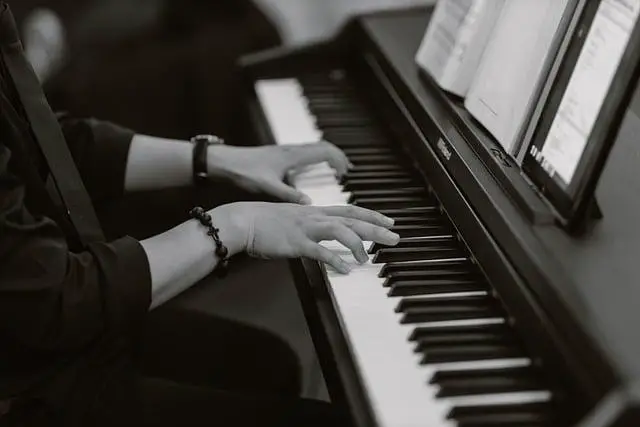Music is like a delicious, complex recipe. And just like adding a dash of cumin or a splash of hot sauce can take a dish from bland to brilliant, using guitar chord substitutions can elevate your music from meh to magnificent. So grab your guitar and get ready to unlock your inner rockstar as we dive into the world of chord subs and take your music to the next level!
Contents
- 1 Exploring the Infinite Possibilities of Chord Substitutions
- 2 Mastering the Geometric Symmetry of Guitar Chords for Substitution
- 3 Decoding the Language of Functional Harmony in Music Theory
- 4 Strategies for Smooth and Creative Chord Transitioning
- 5 Incorporating Jazz Technique into Modern Guitar Playing
- 6 Leveraging Chord Subs to Develop Your Unique Sound
- 7 Navigating the Emotional Palette Through Advanced Chord Substitutions
- 8 FAQs
- 9 Rock on, Rockstar!
Exploring the Infinite Possibilities of Chord Substitutions
So you think you’ve mastered basic chord progressions, huh? Time to step up your game and explore the infinite possibilities of chord substitutions. This musical rabbit hole goes deep, my friends. Strap in and get ready for a wild ride through the cosmos of altered chords and unexpected harmonies.
Forget about your boring old I-IV-V progressions – it’s time to spice things up with some juicy substitutions. Ready to blow your mind? Here are just a few ways you can start thinking outside the box:
- Modal Madness: Swap out your standard major or minor chords for their modal counterparts. Mixolydian, Dorian, Phrygian – the possibilities are as endless as the universe itself.
- Diminished Dominance: Diminished chords are like the unsung heroes of chord substitutions. Use them to add tension and drama to your progressions, and watch your listeners’ jaws drop in awe.
- Augmented Adventure: Feeling adventurous? Throw in some augmented chords for a touch of dissonance and intrigue. Your music will never be the same.
So, fellow explorers of the musical unknown, it’s time to break free from the chains of convention and dive headfirst into the abyss of chord substitutions. Who knows what wondrous sounds await you on the other side? The possibilities are truly infinite – so go forth and create something truly out of this world.

Mastering the Geometric Symmetry of Guitar Chords for Substitution
Unleash the power of geometric symmetry in your guitar playing!
Ever feel like your chord progressions are as random as a squirrel crossing the road? It’s time to tame that chaos with the magic of geometric symmetry. By understanding the patterns and shapes of chords, you can easily substitute one chord for another, creating a seamless and harmonious sound that will leave your audience in awe. Say goodbye to awkward transitions and hello to smooth sailing through your favorite tunes.
Think of chords as your building blocks, each one fitting together like a puzzle piece. With geometric symmetry, you can rearrange those pieces in a million different ways, creating unique and intriguing progressions that will make your music stand out. Instead of sticking to the same old chords, experiment with substitutions to add a fresh twist to your songs.
Not sure where to start? Try these tips to master the art of chord substitution:
- Identify common chord progressions – Study the most popular progressions in music and look for opportunities to substitute chords within them.
- Use inversions to your advantage – Experiment with different inversions of chords to find new and interesting sounds.
- Think outside the box – Don’t be afraid to try unconventional substitutions. Sometimes the most unexpected choices lead to the most beautiful harmonies.
So grab your guitar, unleash your creativity, and start . Your music will thank you!

Decoding the Language of Functional Harmony in Music Theory
Functional harmony in music theory can be super confusing, like trying to read a map upside down in the dark. But fear not, fellow music enthusiasts! We are here to help decode the elusive language of functional harmony for you.
First things first, let’s talk about the almighty chord progression. These sequences of chords are like the building blocks of harmony, laying the foundation for your musical masterpiece. If you see that pesky Roman numeral notation, don’t panic! Just remember that each numeral corresponds to a specific chord in the key you’re playing in. It’s like cracking a secret code, but with more musical flair.
Next up, we have the concept of cadences. These are like musical punctuation marks, signaling the end of a phrase or section. The two most common cadences are the authentic cadence (V-I) and the plagal cadence (IV-I). These bad boys help create that satisfying resolution that makes your ears do a happy dance.
And let’s not forget about the magical world of secondary dominants. These sneaky little chords like to disguise themselves as the dominant of a different key, adding a touch of spice to your harmonies. They’re like the undercover agents of functional harmony, bringing unexpected twists and turns to your musical journey.

Strategies for Smooth and Creative Chord Transitioning
Transitioning between chords during a performance can be nerve-wracking, but with a few sneaky strategies up your sleeve, you’ll be smooth sailing in no time!
First off, don’t be afraid to cheat a little! Use capo to change the key and make those pesky chord changes a whole lot easier. Who said cheating was always a bad thing?
Another trick is to practice switching between chords using a metronome. Not only will this help you stay on beat, but it will also train your muscle memory to make those transitions quicker and more precise. Plus, you can pretend you’re a pro drummer while you’re at it!
Lastly, don’t be afraid to get creative with your chord transitions. Add in some suspensions or arpeggios to spice things up a bit. Who knows, maybe you’ll discover a cool new sound that will make your audience go wild!
%20(1).jpg)
Incorporating Jazz Technique into Modern Guitar Playing
So you want to take your guitar playing to the next level and incorporate some jazz technique, huh? Well, get ready to expand your musical horizons and impress your friends with your fancy new skills!
First things first, let’s talk about chord voicings. Jazz guitarists love their fancy chords, so start by learning some new voicings like the 9th, 11th, and 13th chords. Trust me, those basic open chords are so last season. Mix it up and spice up your playing with some jazzy goodness.
Next on the agenda: improvisation. Jazz is all about riffing off each other and creating magic in the moment. So throw away those pre-rehearsed solos and start experimenting with scales and arpeggios. Don’t be afraid to make mistakes – after all, jazz is all about embracing the unexpected.
Lastly, don’t forget to work on your rhythm. Jazz music has its own unique groove that you need to tap into. Practice playing with different time signatures and syncopated rhythms to really nail that jazzy feel. Before you know it, you’ll be swinging like a pro!
Leveraging Chord Subs to Develop Your Unique Sound
So you want to take your music to the next level, huh? Well, look no further than . Trust me, it’s like adding a secret ingredient to your musical recipe that will make your tunes stand out from the rest!
Picture this: you’re jamming away on your guitar or keyboard, strumming those basic chords like a pro. But then, *ding!* a lightbulb goes off in your head – why not switch things up with some spicy chord substitutions? It’s like swapping out plain old vanilla for a scoop of double chocolate fudge ripple. Your audience’s ears won’t know what hit ’em!
With chord subs, the possibilities are endless. You can experiment with different voicings, add in unexpected dissonances, or throw in some jazzy extensions for good measure. Who knows, you might stumble upon a combination that becomes your musical signature – the secret sauce that sets you apart from the crowd.
So go ahead, take the plunge and dive into the world of chord substitutions. Your future self will thank you for it – and who knows, you might just discover a whole new dimension to your music that you never knew existed. Happy experimenting!
Have you ever played a chord progression that left you feeling emotionally confused? Like a C major turning into a D minor without warning, leaving you with a sense of existential dread? Well fear not, because advanced chord substitutions are here to save the day!
With the power of advanced chord substitutions, you can transform a simple major chord into a complex, emotionally rich progression that will have your audience weeping with joy. Say goodbye to boring old triads and hello to seventh chords, ninths, elevenths, and thirteenths. Your music will never be the same!
But beware, with great power comes great responsibility. Using advanced chord substitutions requires a delicate touch and a keen ear for harmony. One wrong note and you could send your listeners spiraling into a musical abyss. So tread lightly, my friends, and remember to always resolve those tensions!
So buckle up, music lovers, and get ready to dive into the vast ocean of possibilities that advanced chord substitutions have to offer. Embrace the unexpected, explore the uncharted territories of harmony, and most importantly, have fun creating music that moves both the heart and the soul.
FAQs
Why should I bother learning about chord substitutions for guitar?
Because playing the same old chords over and over is like eating plain oatmeal every day – boring! Chord substitutions add flavor and spice to your music, taking it from bland to grand in no time.
How do chord substitutions elevate my music?
Think of chord substitutions as adding fancy decorations to a plain cake. They make your music sound more complex, interesting, and downright impressive. Your listeners will be like, “Wow, who knew this guy could play like that?”
Do I need to be a guitar virtuoso to use chord substitutions?
Absolutely not! Chord substitutions are like secret weapons that even beginners can use to instantly sound more advanced. It’s like the guitar version of fake it till you make it – except you’ll actually sound legit.
Where can I find chord substitutions to use in my music?
The internet is your best friend when it comes to finding chord substitutions. There are endless resources, from websites to YouTube tutorials, that can help you unlock the artistry of chord substitutions. And hey, if all else fails, just make up your own – there are no rules in music!
Rock on, Rockstar!
Congratulations on taking the first steps towards elevating your music with guitar chord substitutions! Armed with this knowledge, you’re ready to unlock a whole new dimension of artistry in your music. So grab your guitar, strum those chords, and let your creativity shine through. Remember, the only limit is your imagination. Keep rockin’ and keep experimenting with those chord subs! Your fans will thank you for it.



